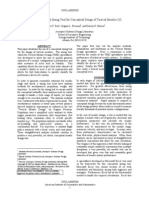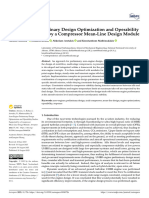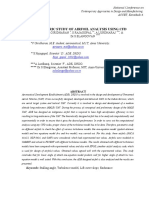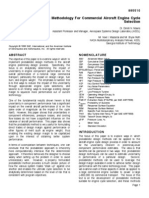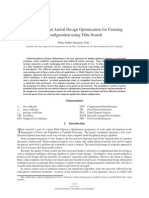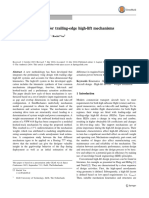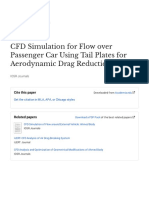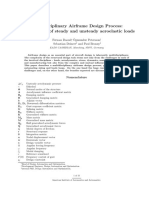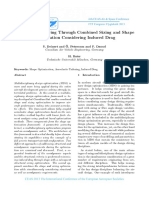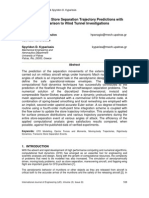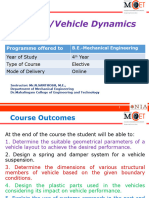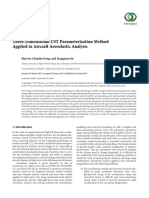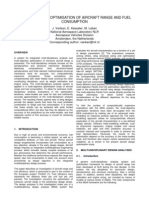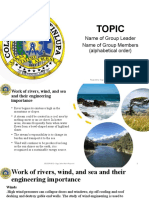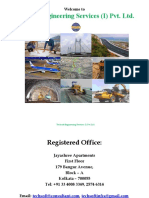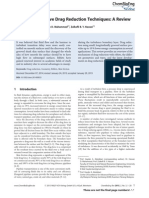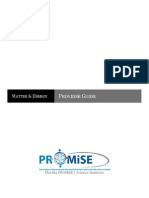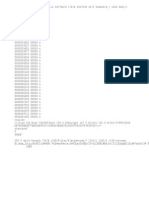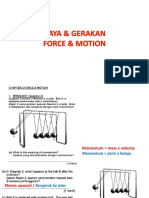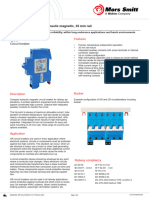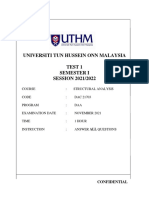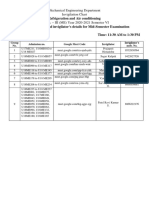Parametric Analysis of Aerodynamic Characteristics of Launch Vehicles With Strap-On Boosters
Parametric Analysis of Aerodynamic Characteristics of Launch Vehicles With Strap-On Boosters
Uploaded by
ali68fat64Copyright:
Available Formats
Parametric Analysis of Aerodynamic Characteristics of Launch Vehicles With Strap-On Boosters
Parametric Analysis of Aerodynamic Characteristics of Launch Vehicles With Strap-On Boosters
Uploaded by
ali68fat64Original Description:
Original Title
Copyright
Available Formats
Share this document
Did you find this document useful?
Is this content inappropriate?
Copyright:
Available Formats
Parametric Analysis of Aerodynamic Characteristics of Launch Vehicles With Strap-On Boosters
Parametric Analysis of Aerodynamic Characteristics of Launch Vehicles With Strap-On Boosters
Uploaded by
ali68fat64Copyright:
Available Formats
ICAS 2002 CONGRESS
PARAMETRIC ANALYSIS OF AERODYNAMIC CHARACTERISTICS OF LAUNCH VEHICLES WITH STRAP-ON BOOSTERS
Arash Naghib-Lahouti1, Amir Nejat2, Taravat Khadivi3 1- Faculty Member 2,3-Senior Research Engineers Aerospace Research Institute, PO Box 15875-3885,Tehran, Iran Keywords: launch vehicles, aerodynamic, strap-on boosters, parametric analysis Abstract An engineering code has been developed for estimation of longitudinal aerodynamic coefficients of a multi-body launch vehicle with strap-on boosters, based on their geometric characteristics and flow conditions. The code, which incorporates data from empirical/analytical methods, CFD analysis, wind tunnel tests and similar engineering codes has been used for parametric analysis of the effects of angular position of strap-ons, the gap between the core and strap-ons, angle of attack, and Mach number on aerodynamic coefficients (CN and CA) of a generic geometry, defined by statistical investigation of actual launch vehicles. Results indicate suitable accuracy within the range of 0<<16 and M<5.0 for the purpose of preliminary aerodynamic design. 1 Introduction Launch vehicles are used for delivering payloads to a specified altitude at the proper orbital velocity. The usual values of orbital velocities are too high to be achieved with a single stage vehicle [1]. A considerable part of a launch vehicles propellant is consumed during the early stages of acceleration after lift-off, making it unnecessary to carry the partially depleted tanks, which can be ejected after depletion. On the other hand, various levels of thrust might be required in different phases of flight. Because of these problems, efforts have been made to develop propulsion systems with variable thrust. A multi stage system is a trivial solution [2,3]. Parallel staging, which appears in many launch vehicles developed since 1970s, is one of the most frequently used configurations. In this type of staging configuration, 2 to 9 solid or liquid propellant boosters join the first stage as strap-ons. They are usually ignited simultaneously together with the core engine(s) to provide the maximum thrust, and are separated from the core upon burn-out, to reduce the total weight of the climbing vehicle. Despite their positive contribution to the performance of the vehicle, they bring about some difficulties to the design process. The strap-on boosters usually have large volumes and affect the external geometry considerably. The complex flow field around the multiple bodies, and the interference effects among them causes problems in the vehicles aerodynamics. The vehicles experiences increased drag while the boosters are on, and safe separation of the boosters in an interference dominated flow field is also of great importance. These issues show the necessity of aerodynamic analysis with various levels of accuracy throughout the design process. The estimated aerodynamic characteristics are particularly useful for structural/thermal analysis, trajectory and stability calculations, and the design and sizing of separation mechanisms. The number of published articles in the field of multi body launch vehicle aerodynamics is unexpectedly low. A few selected studies are reviewed herein. Reference [3], describes the studies on launch vehicle aerodynamics at Vikram space
264.1
ARASH NAGHIB-LAHOUTI, AMIR NEJAT, TARAVAT KHADIVI
center of India. Flow around various geometries of launch vehicles are modeled using panel method, to study the effects of geometric parameters such as number of strap-ons, the ratio of strap-on radius to core stage radius, and the gap between the core and strap-ons on the vehicles aerodynamic characteristics. Reference [4] deals with numerical simulation of inviscid supersonic flow around the multi body configuration using overlapping grid technique. Eulers equations have been integrated in their conservative form, and time marching method has been used for capturing shock waves. Flow pattern around the launch vehicle and shock reflections in the gap have been studied at zero angle of attack. Reference [5] reports numerical solution of inviscid supersonic flows around a launch vehicle with 4 strap-on boosters. The overlapping grid technique has been used to simulate the flow at various angles of attack. Flow in the gap and the local subsonic flow in that region at a non-zero angle of attack have been addressed for the first time in this study. The effects of gap size and Mach number on the interference dominated flow field around the vehicle are investigated. A new method called NND has been employed for solving Eulers equations, and time marching has been used for capturing shock and expansion waves in the flow field. An example of experimental investigation of the effects of strap-on boosters on aerodynamic characteristics of a launch vehicle is presented in reference [6]. In that study, the effects of adding strap-ons of various sizes on CN, CA and CM in a range of supersonic Mach numbers have been evaluated. In most references, the geometric model represents an actual launch vehicle in the early stages of its development, and few variations of configuration and geometry are dealt with. Flight conditions and velocity regimes are also limited to those occurring in each vehicles actual or estimated flight profile.
2 Engineering codes for aerodynamic analysis and design of launch vehicles Analytical methods, empirical techniques, CFD and wind tunnel testing are commonly used for aerodynamic analysis of a launch vehicle depending on the level of accuracy needed in different phases. Each of these tools has their own specific advantages and disadvantages. In the conceptual design phase of a launch vehicle with strap-on boosters, a preliminary estimate of the vehicles aerodynamic coefficients is needed, while the external shape and dimensions of each proposed configuration is yet to be defined and fixed. Several cycles of overall aerodynamic analysis might be necessary before selecting a final configuration and fixing the external geometry through a compromise with other aspects of the design process such as payload capabilities, propulsion and structural considerations. Analytical methods are usually limited to simple geometries and simplified flow conditions. Therefore, they are difficult, if not impossible, to apply in such a problem. CFD codes require considerable computer resources and time for producing appropriate results, and are hardly economic for use as an intermediate tool in conceptual design cycles. Wind tunnel tests usually produce the most dependable results, but require a fixed external geometry, which can be far from being achieved in conceptual design. The costs associated with testing numerous proposed configurations are usually beyond limits of a conceptual design process [6,7]. As a result, an engineering code may be the only feasible tool for conceptual design. But it has to satisfy two important requirements. It must be able to handle the specific geometry and configuration of the vehicle, and its database, which normally integrates analytical and empirical techniques, must cover the intended flight conditions [8]. For example Missile Datcom, a well-known engineering code, covers a major part of the atmospheric flight regime of a launch vehicle, but is not able to handle a multi body configuration with strapon boosters.
264.2
PARAMETRIC ANALYSIS OF AERODYNAMIC CHARACTERISTICS OF
To overcome this shortcoming, an engineering code named AEROLAUNCH is being developed by the authors. This code, which is similar to Missile Datcom in structure, is able to produce longitudinal aerodynamic coefficients (CN, CA, CM) for a launch vehicle with strap-on boosters in a range of flight conditions. Results of extensive CFD modeling and analysis of such geometries, and wind tunnel tests to verify the results, are incorporated in the code. With enrichment of the codes database through more CFD analysis and wind tunnel tests, its capabilities in terms of acceptable geometries and flight conditions are still being expanded. 3 Initial validation To evaluate performance and accuracy of the code introduced in section 2, wind tunnel test results for a rocket with strap-on boosters [9] are compared with the codes results. The test geometry is shown in figure 5. The experiments have been conducted with two types of strapons, named Large Booster and Small Booster. The codes results for CN in various Mach numbers and angles of attack have been compared with experimental results for both types of boosters. In most cases, the codes results display better agreement with experimental results when small boosters are on. This trend of agreement remains almost unchanged in all Mach numbers. The results for CN at M=2.36 with different configurations are shown in figure 6 for comparison. It can be seen that the computational and experimental results follow the same trend when angle of attack varies, and the values are also in a relatively good agreement. The maximum difference between computational and experimental results is around 14% in the body+booster configuration and around 20% in the wing+body+booster configuration. Since sufficient information is not provided in reference [9] about calculation of base drag, a meaningful comparison between the codes results and the experimental results for axial force is not possible. However, even when the
entire component of base drag is accounted for in the code, the results fall 25-50% short of experimental results. 4 Parametric analysis Considering the promising results of the initial validation of AEROLAUNCH, a generic launch vehicle with strap-on boosters has been defined, and a systematic investigation of the effects of geometric and flow parameters on its aerodynamic characteristics has been conducted. These parameters include number of strap-ons, radius ratio, gap size, angular position of strapons around the core, Mach number and angle of attack. All calculations are carried out at standard sea level conditions, and the cores cross-section area is used as reference area.
4.1 Definition of the generic geometry According to the information provided in reference [10], 29 families of launch vehicles exist. Taking different models in each family into account, we will have a total of 74 models of launch vehicles. 33 models (44% of the total) use strap-on boosters. In this section, it is intended to determine the dimensional data required for defining a generic geometry with strap-on boosters. The aim of defining this generic geometry is to investigate the effects of a number of parameters on its aerodynamic characteristics. Therefore, it is necessary to eliminate other parameters affecting the characteristics as much as possible. The parameters selected for definition of the geometry are introduced in Figure 1, which displays the simplified geometry used for derivation of the parameters. A number of assumptions were made in order to simplify the geometry and the task of obtaining data for the parameters. These assumptions are presented graphically in Figures 2, 3 and 4. Considering the assumptions, data for all launch vehicles except four, which have essential differences in shape with the generic configuration, have been derived. For some items of data, numerical values were not
264.3
ARASH NAGHIB-LAHOUTI, AMIR NEJAT, TARAVAT KHADIVI
provided in reference [10], and the values had to be determined by scaling the related drawings. 14 out of 33 models of launch vehicles with strap-on boosters have 4 boosters. 13 models have 2 boosters, 4 models have 6 boosters, 2 models have 9 boosters, and one has 3 boosters. (One model has two configurations: one with 2 and one with 4 boosters.) The dimensional values are rounded before being used for aerodynamic analysis, in order to simplify data handling. The final selected dimensions of the generic geometry are presented in table 1.
Table 1- Parameters defining the simplified geometry Parameter Parameter L 50.0 m LS 21.0 m LN 4.5 m LNS 3.35 m D 3.7 m DS 2.0 m R 0.657 m RS 0.5 m 17 S 14.5
reduce as the number of strap-ons is increased from 2 to 6. The angular position of strap-ons does not have any noticeable effect on CA. 4.3 Effects of the gap between strap-ons and the core In some launch vehicles, a gap exists between the core and strap-ons. The size of this gap affects aerodynamic interference between strapons and the core. Figures 14 and 15 show CN-Alpha curves for various gap sizes at M=0.6 for Phi0 and Phi1 cases. Figures 16 and 17 show the same results at M=3.0. The figures indicate that an increase in gap size does not affect CN in Phi0 case, but in Phi1 case an increase in gap size causes CN to increase in each angle of attack. Figures 18 and 19 show the effects of gap size on CA in Phi0 case. The figures indicate that the effect of gap size on CA is practically negligible. The results presented in this section are obtained by varying the gap size between 0 and 1m with 0.25m increments, for a 2 strap-on configuration in which each strap-on has a diameter of 2m. 4.4 Effects of strap-on radius To investigate the effect of the radius of strapons, RS (strap-on radius) is varied between 0.25m and 1m for a constant gap size of 0.5m. Figures 20-23 show variations of CN-Alpha at M=0.6 and M=3.0 when the radius is changed in both Phi0 and Phi1 cases. It can be noticed that an increase in the radius ratio causes CN to increase in constant angle of attack. This effect is more evident in Phi1 case. Variation of CAAlpha for different values of RS is displayed in figures 24 and 25. CA increases almost linearly as RS is increased, but remains almost constant when angle of attack is changed within a limited range. The same behaviour has also been reported in reference [9]. 4.5 Effects of the number of strap-ons Effects of the number of strap-ons have been studied by analysing configurations with 0, 2, 4
264.4
4.2 Effects of angular position of strap-on boosters Angular position of strap-on boosters affects aerodynamic coefficients of the vehicle in nonzero angles of attack. To investigate these effects, two cases have been analyzed. These cases, named Phi0 and Phi1, represent two different ways of positioning strap-ons around the core (Figure 7). Obviously, as the number of strap-ons is increased, the difference between Phi0 and Phi1 cases reduces. Figures 8 and 9 show variations of CN vs. angle of attack in subsonic (M=0.6) and supersonic (M=3.0) regimes for body alone and body with 2 strap-ons in Phi0 and Phi1 cases. It can be seen that in Phi1 case, where strap-ons are in yaw plane, CN is greater than that of Phi0 case. This can be explained by noting that in Phi0 case strap-ons are widely affected by the cores flow field in non-zero angles of attack. Their effective area for generation of normal force is therefore reduced. Figures 10-13 show the same effect in Phi0 and Phi1 cases for the 4 and 6 strap-on configurations in M=0.6 and M=3.0, respectively. The figures indicate that the difference between Phi0 and Phi1 cases tends to
PARAMETRIC ANALYSIS OF AERODYNAMIC CHARACTERISTICS OF
and 6 strap-ons. As the number of strap-ons is increased, CN increases at each constant angle of attack. The increase in CN is greater in Phi1 case (Figures 26-29). As the number of strap-ons is increased, CA increases almost linearly in a manner similar the one described in section 4.4. The curves presented in figures 30 and 31 are for Phi0 case. The curves for Phi1 case display the same behaviour and are not presented. 4.6 Effects of angle of attack Except for those instances when the vehicle encounters wind gradients or performs transient manoeuvres, the angle of attack remains close to zero. In this study, a range of angles of attack from =0 to =10 is considered for investigation of the effects of flow direction on aerodynamic characteristics. In all of the curves presented in sections 4.2 through 4.5, the independent variable is angle of attack. As those curves indicate, the normal force coefficient CN increases almost linearly when angle of attack increases in subsonic speeds. But in supersonic region, non-linear effects are evident in CNAlpha curves. The curves also indicate that CA decreases slightly with an increase in angle of attack. This decrease can be explained considering variation of the direction of the free stream velocity vector. The major part of the change in the value of CA is because of the core, since variation of CA with angle of attack is almost negligible for strap-on boosters [9]. 4.7 Effects of Mach number A launch vehicle experiences all speed regimes, from subsonic to hypersonic, during its flight. But it faces different speed regimes in different configurations. For example, the vehicles that use strap-ons usually release them in supersonic speeds. Therefore, it is usually only the core that faces hypersonic speeds. The flight profile, which defines the vehicles altitude, speed and position and occurrence of events such as stage separation in terms of the elapsed time, is different for every launch vehicle. Samples of actual flight profiles are presented in references [7] and [10].
All of the results presented so far in this study were for two Mach numbers only: M=0.6 as a representative of subsonic regime and M=3.0 as a representative of supersonic regime. However, to further evaluate the effects of Mach number, limited calculations have been performed in other Mach numbers for vehicles with 0,2 and 6 strap-ons in Phi0 configuration, at selected angles of attack of 0, 4 and 8. The results for CN are plotted in figures 32-34 for a range of Mach numbers from 0.6 to 5.0. The sudden change of CN at transonic Mach numbers, especially at higher angles of attack can be clearly noticed. As Mach number is increased, CN increases to reach its maximum at high transonic speeds. Afterwards, CN decreases to reach a relative minimum at around M=4. CA behaves similarly as Mach number varies. In the transonic region, CA shows a rapid rise because formation of weak shock waves begins. Figures 35 and 36 show variation of CA with Mach number. 5 Conclusion In this study, the role of different approaches to aerodynamic analysis of launch vehicles in different design phases was briefly described. A generic geometry was selected through statistical investigation of existing launch vehicles with strap-on boosters. The generic geometry was modeled for analysis by an engineering code (AEROLAUNCH), to study the effects of such parameters as angular position of strap-ons around the core, radius and number of strap-ons, angle of attack and Mach number on the vehicles normal and axial force coefficients (CN and CA). Generally, the contribution of strap-ons to the vehicles normal force reduces as they get closer to the pitch plane, because their exposed surface is reduced at non-zero angles of attack. Alternatively, when strap-ons are close to the yaw plane, their exposed surface is larger and this causes an increase in CN. The gap between the core and the strapons does not affect CN and CA when strap-ons
264.5
ARASH NAGHIB-LAHOUTI, AMIR NEJAT, TARAVAT KHADIVI
are positioned according to the configuration named Phi0. The same behavior is observed at all angles of attack having been studied. When the strap-ons are placed in the yaw plane (Phi1 case), CN increases when the gap is increased, while CA remains practically unaffected. When the strap-ons radius is increased (relative to the core stage), CN and CA increase. Naturally, the interference effects between the core and the strap-ons are also strengthened. Increasing the number of strap-ons causes both CN and CA to increase proportionately in both Phi0 and Phi1 cases. Angular position of the added strap-ons affects the trend by which CN increases. As angle of attack increases, CN increases while CA decreases with a small slope. In subsonic speeds, CN and CA increase due to compressibility effects when Mach number is increased. In transonic speeds, a rapid increase of CA is observed, which is because of the drag rise due to formation of weak shock waves. CN also increases considerably in this range. As Mach number increases further in the supersonic range, CN and CA decrease with a relatively small slope. The promising results of the early validation of AEROLAUNCH, presented herein, encourage the authors to enrich the codes database and extend its capabilities to handle more complex geometries and flow condition by performing more CFD analysis and wind tunnel test on the selected geometries. References
[1] Malina, F.J. and M. Summerfield. The problem of escape from the earth by rocket. J. of Aeronautical Sciences, V.14, pp. 476-478, Aug. 1947. [2] Cornelisse, J.W. et al. Rocket propulsion and space flight dynamics. Pitman Pub., 1979. [3] Devasia, K.J. et al. Investigation of inviscid flow field interference effects in strap-on configurations using panel method. Proc. 13th Int. Symposium on Space Science and Technology, Tokyo, Japan, June 1982. [4] Singh, K.P. et al. Numerical simulation of inviscid supersonic flows over a launch vehicle with strap-on boosters. AIAA Paper, AIAA-87-0213-CP, 1987. [5] Zhang Lumin, Yu Zechu and Yan Yongjian. Numerical simulation of inviscid supersonic flow
over multiple bodies. AIAA Paper, AIAA-90-3099CP, 1990. [6] Mendenhall, M.R. et al. Aerodynamic design and analysis of a reusable launch vehicle. Proc. ICAS 2000 Conference, Harrogate, UK, Aug. 2000. [7] Mendenhall, M.R. et al. Integrated aerodynamic design and analysis of launch vehicles. AIAA Paper, AIAA-2001-0263, 2001. [8] Moore, F.G. et al. Evaluation and improvements to the Aeroprediction code based on recent test data. Journal of Spacecraft and Rockets, V.37, No.6, Nov.Dec. 2000. [9] Leroy-Spearman M. and R.H. Fournier. Effects of strap-on boosters on the aerodynamic characteristics of a simulated launch vehicle at Mach numbers from 1.50 to 2.86. NASA Technical Memorandum X-2491, Feb. 1972. [10] Isakowitz, S.J. The international reference guide to space launch systems. 3rd Ed., AIAA, USA, 1999.
264.6
PARAMETRIC ANALYSIS OF AERODYNAMIC CHARACTERISTICS OF
Figure 1- Simplified generic geometry
Figure 5- The vehicle with strap-on boosters (ref. [9])
20
15
CN
Figure 2- Equivalent nose cone
10 -0.2
-0.4
-0.6
0 0 10 20
-0.8
Figure 3- Equivalent payload fairing Figure 6- Comparison of results with those provided in ref. [9]
Figure 4- Equivalent core body
Figure 7- Different ways of positioning strap-ons around the core
CM 0.8 0.6 0.4 0.2 0
25
C N body alone-AEROLAUNCH C M body alone-AEROLAUNCH C N body and wings-AEROLAUNCH C M body and wings-AEROLAUNCH C N wing on small booster-AEROLAUNCH C M wing on small booster-AEROLAUNCH C N body alone [Ref.4] C M body alone [Ref.4] C N body and wings [Ref.4] C M body and wings [Ref.4] C N body on small booster [Ref.4] C M body on small booster [Ref.4]
264.7
ARASH NAGHIB-LAHOUTI, AMIR NEJAT, TARAVAT KHADIVI
(XY) 31 Jan 2001 Effect of Strap-on Position on CN-Alpha
(XY) 03 Feb 2001 M=3,Effect of Strap-on Position on CN-Alpha
2.5
2 S/O Phi0 2 S/O Phi1 0 S/O
1.5
4 S/O Phi0 4 S/O Phi1 0 S/O Phi0
1.5
CN
CN
1 0.5
0 2 4 6 8 10
0.5
Alpha
Alpha
10
Figure 8- Effect of strap-on position on CN for 2 strap-ons (M=0.6)
Figure 11- Effect of strap-on position on CN for 4 strapons (M=3.0)
(XY) 03 Feb 2001 M=3,Effect of Strap-on Position on CN-Alpha
(XY) 31 Jan 2001 Effect of Strap-on Position on CN-Alpha
2 S/O Phi0 2 S/O Phi1 0 S/O Phi0
6 S/O Phi0 6 S/O Phi1 0 S/O
1.5
1.5
CN
CN
1 1 0.5 0 0 2 4 6 8 10 0 0
0.5
Alpha
Alpha
10
Figure 9- Effect of strap-on position on CN for 2 strap-ons (M=3.0)
Figure 12- Effect of strap-on position on CN for 6 strapons (M=0.6)
(XY) 31 Jan 2001 Effect of Strap-on Position on CN-Alpha
(XY) 03 Feb 2001 M=3,Effect of Strap-on Position on CN-Alpha
2 4 S/O Phi0 4 S/O Phi1 0 S/O 1.5
2.5
6 S/O Phi0 6 S/O Phi1 0 S/O Phi0
CN
0.5
10
CN
1.5
0.5
Alpha
10
Figure 10- Effect of strap-on position on CN for 4 strapons (M=0.6)
Alpha
Figure 13- Effect of strap-on position on CN for 6 strapons (M=3.0) 264.8
PARAMETRIC ANALYSIS OF AERODYNAMIC CHARACTERISTICS OF
(XY) 31 Jan 2001 Phi=0,CN-Alpha,2 S/O: Gap Effects
(XY) 03 Feb 2001 M=3,Phi=1,CN-Alpha,2 S/O: Gap Effects
2.8 0.7 0.6 0.5 G=0 G=0.25 G=0.5 G=0.75 G=1 2.6 2.4 2.2 2 1.8 1.6 G=0 G=0.25 G=0.5 G=0.75 G=1
CN
0.4 0.3 0.2 0.1 0
CN
0 2 4 6 8 10
1.4 1.2 1 0.8 0.6 0.4 0.2 0
Alpha
Alpha
10
Figure 14- Effect of gap size on CN (Phi0, M=0.6)
Figure 17- Effect of gap size on CN (Phi1, M=3.0)
(XY) 31 Jan 2001 Phi=1,CN-Alpha,2 S/O: Gap Effects
(XY) 31 Jan 2001 Phi=0,CA-Alpha,2 S/O: Gap Effects
0.26 G=0 G=0.25 G=0.5 G=0.75 G=1 0.2575 0.255 0.2525
1.5
G=0 G=0.25 G=0.5 G=0.75 G=1
CN
CA
1 0 0 2 4 6 8 10
0.25
0.2475 0.245 0.2425 0.24
0.5
Alpha
Alpha
10
Figure 15- Effect of gap size on CN (Phi1, M=0.6)
Figure 18- Effect of gap size on CA (Phi0, M=0.6)
(XY) 03 Feb 2001 M=3,Phi=0,CN-Alpha,2 S/O: Gap Effects
(XY) 03 Feb 2001 M=3,Phi=0,CA-Alpha,2 S/O: Gap Effects
0.55 1.2 1.1 1 0.9 0.8 G=0 G=0.25 G=0.5 G=0.75 G=1 G=0 G=0.25 G=0.5 G=0.75 G=1
0.54
CN
0.6 0.5 0.4 0.3 0.2 0.1 0 0 2 4 6 8 10 0.52 0 2 4 6 8 10 0.53
Alpha
CA
0.7
Alpha
Figure 16- Effect of gap size on CN (Phi0, M=3.0)
Figure 19- Effect of gap size on CA (Phi0, M=3.0)
264.9
ARASH NAGHIB-LAHOUTI, AMIR NEJAT, TARAVAT KHADIVI
(XY) 31 Jan 2001 Phi=0, Gap=0.5, CN-Alpha, Rs/Rc Effects
(XY) 03 Feb 2001 M=3,Phi=0, Gap=0.5, CN-Alpha, Rs/Rc Effects
2.2 0.7 0.6 0.5 R=0.25 R=0.5 R=0.75 R=1.0 2 1.8 1.6 1.4 R=0.25 R=0.5 R=0.75 R=1.0
CN
0.4 0.3 0.2 0.1 0
CN
0 2 4 6 8 10
1.2 1 0.8 0.6 0.4 0.2 0 0 2 4 6 8 10
Alpha
Alpha
Figure 20- Effect of strap-on radius on CN (Phi0, M=0.6)
Figure 23- Effect of strap-on radius on CN (Phi1, M=3.0)
(XY) 31 Jan 2001 Phi=0, Gap=0.5, CN-Alpha, Rs/Rc Effects
(XY) 31 Jan 2001 Phi=1, Gap=0.5, CA-Alpha, Rs/Rc Effects
1.8 1.6 1.4 1.2 R=0.25 R=0.5 R=0.75 R=1.0
0.29 0.28 0.27 0.26 R=0.25 R=0.5 R=0.75 R=1.0
CN
CA
0 2 4 6 8 10
1 0.8
0.25 0.24
0.6 0.4 0.2 0 0.23 0.22 0.21
Alpha
Alpha
10
Figure 21- Effect of strap-on radius on CN (Phi1, M=0.6)
Figure 24- Effect of strap-on radius on CA (Phi0, M=0.6)
(XY) 03 Feb 2001 M=3,Phi=0, Gap=0.5, CN-Alpha, Rs/Rc Effects
(XY) 03 Feb 2001 M=3,Phi=1, Gap=0.5, CA-Alpha, Rs/Rc Effects
1.2 1.1 1 0.9 0.8 R=0.25 R=0.5 R=0.75 R=1.0
0.56 R=0.25 R=0.5 R=0.75 R=1.0
0.55
CN
0.6 0.5 0.4 0.3 0.2 0.1 0 0 2 4 6 8 10 0.51 0 2 4 6 8 10 0.52 0.53
Alpha
CA
0.7
0.54
Alpha
Figure 22- Effect of strap-on radius on CN (Phi0, M=3.0)
Figure 25- Effect of strap-on radius on CA (Phi0, M=3.0)
264.10
PARAMETRIC ANALYSIS OF AERODYNAMIC CHARACTERISTICS OF
(XY) 31 Jan 2001 Phi=0 CN-Alpha No of S/O
(XY) 03 Feb 2001 M=3,Phi=1 CN-Alpha No of S/O
2 1.75 1.5 1.25 0 2 4 6 S/O S/O S/O S/O 2.5 0 2 4 6 S/O S/O S/O S/O
CN
0.75 0.5
CN
0 2 4 6 8 10
1.5
0.5 0.25 0 0
Alpha
Alpha
10
Figure 26- Effect of the number of strap-ons on CN (Phi0, M=0.6)
Figure 29- Effect of the number of strap-ons on CN (Phi1, M=3.0)
(XY) 31 Jan 2001 Phi=1 CN-Alpha No of S/O
(XY) 31 Jan 2001 Phi=0 CA-Alpha-No of S/O
0.33 2 0 2 4 6 S/O S/O S/O S/O 0.32 0.31 0.3 0.29 0 2 4 6 S/O S/O S/0 S/O
1.5
CN
0.5 0.24 0.23 0 0 2 4 6 8 10 0 2 4 6 8 10
Alpha
CA
0.28 0.27 0.26 0.25
Alpha
Figure 27- Effect of the number of strap-ons on CN (Phi1, M=0.6)
Figure 30- Effect of the number of strap-ons on CA (Phi0, M=0.6)
(XY) 03 Feb 2001 M=3,Phi=0 CN-Alpha No of S/O
(XY) 03 Feb 2001 M=3,Phi=0 CA-Alpha-No of S/O
0.59 2.5 0 2 4 6 S/O S/O S/O S/O 0.58 0.57 0.56 0 2 4 6 S/O S/O S/0 S/O
CN
0.5 0.52 0.51 0 2 4 6 8 10 0 2 4 6 8 10
Alpha
CA
1.5
0.55 0.54 0.53
Alpha
Figure 28- Effect of the number of strap-ons on CN (Phi0, M=3.0)
Figure 31- Effect of the number of strap-ons on CA (Phi0, M=3.0)
264.11
ARASH NAGHIB-LAHOUTI, AMIR NEJAT, TARAVAT KHADIVI
(XY) 03 Feb 2001 EFFECTS OF MACH NO. ON CN - PHI=0
(XY) 03 Feb 2001 EFFECTS OF MACH NO. ON CN - PHI=0
0.5
1.3 1.2 1.1
0.4
1 0.9
0.3
0.8
CN
0.2 0 S/O ALPHA=0 0 S/O ALPHA=4 0 S/O ALPHA=8
CN
0.7 0.6 0.5 0.4 0.3 0.2 6 S/O ALPHA=0 6 S/O ALPHA=4 6 S/O ALPHA=8
0.1
0 1 2 3 4 5
0.1 0 1 2 3 4 5
MACH
MACH
Figure 32- Effect of Mach number on CN (Body alone)
Figure 34- Effect of Mach number on CN (6 Strap-ons, Phi0)
(XY) 03 Feb 2001 EFFECTS OF MACH NO. ON CN - PHI=0
(XY) 03 Feb 2001 EFFECTS OF MACH NO. ON CA - PHI=0
0.6 0.6 0.5 0.5
0.4
CN
0.2
0.1
2 S/O ALPHA=0 2 S/O ALPHA=4 2 S/O ALPHA=8
CA
0.3
0.4 0 S/O ALPHA=0 0 S/O ALPHA=4 0 S/O ALPHA=8
0.3
0 1 2
MACH
0.2
MACH
Figure 33- Effect of Mach number on CN (2 Strap-ons, Phi0)
Figure 35- Effect of Mach number on CA (Body Alone)
(XY) 03 Feb 2001 EFFECTS OF MACH NO. ON CA - PHI=0
0.6
CA
0.5
0.4
6 S/O ALPHA=0 6 S/O ALPHA=4 6 S/O ALPHA=8
0.3 1 2 3 4 5
MACH
Figure 36- Effect of Mach number on CA (6 Strap-ons, Phi0)
264.12
You might also like
- Research ProposalDocument9 pagesResearch ProposalSrinivasan Viswanathan100% (1)
- Airfoil Shape Optimization For A F1 Car Front Wing Using MOGA-libreDocument10 pagesAirfoil Shape Optimization For A F1 Car Front Wing Using MOGA-libreissamouNo ratings yet
- Aeroservoelastic Modeling, Analysis, and Design Techniques PDFDocument12 pagesAeroservoelastic Modeling, Analysis, and Design Techniques PDFkarthekeyanmenonNo ratings yet
- ACX - Rules For Audiobook ProductionDocument4 pagesACX - Rules For Audiobook Productioni.s.No ratings yet
- Transonic Axial-Flow Blade Shape Optimization Using Evolutionary Algorithm and Three-Dimensional Navier-Stokes SolverDocument11 pagesTransonic Axial-Flow Blade Shape Optimization Using Evolutionary Algorithm and Three-Dimensional Navier-Stokes SolverEslam NagyNo ratings yet
- CFD in Launch Vehicle ApplicationsDocument6 pagesCFD in Launch Vehicle ApplicationsaeroalanNo ratings yet
- Numerical, Wind Tunnel, and On Track Study of Monash 2002 Aero PackageDocument13 pagesNumerical, Wind Tunnel, and On Track Study of Monash 2002 Aero PackageZizo StarkNo ratings yet
- Role of CFD in Missile Aerodynamic Design: A Review of Recent Efforts at RaytheonDocument20 pagesRole of CFD in Missile Aerodynamic Design: A Review of Recent Efforts at Raytheonbahar1234No ratings yet
- Stability Derivatives of X-11 AircraftDocument14 pagesStability Derivatives of X-11 AircrafthaivijayanandNo ratings yet
- Computers & Fluids: Mine YumusßakDocument13 pagesComputers & Fluids: Mine YumusßakshamoonjamshedNo ratings yet
- Eects of Aircraft Integration On Compact Nacelle AerodynamicsDocument35 pagesEects of Aircraft Integration On Compact Nacelle AerodynamicsHao LiuNo ratings yet
- Aermacchi Landing GearDocument10 pagesAermacchi Landing GearRahman Ehvan100% (2)
- Aerodynamic Data Generation TechniquesDocument21 pagesAerodynamic Data Generation TechniquesThiago BoaventuraNo ratings yet
- Powered, Aerodynamic Simulations of An Airbreathing, Hypersonic VehicleDocument20 pagesPowered, Aerodynamic Simulations of An Airbreathing, Hypersonic VehicleNice tryNo ratings yet
- Ads 2011-2553 PDFDocument11 pagesAds 2011-2553 PDFMike BrynerNo ratings yet
- Use of A Conceptual Sizing Tool For Conceptual Design of Tactical Missiles (U)Document11 pagesUse of A Conceptual Sizing Tool For Conceptual Design of Tactical Missiles (U)paviliondmNo ratings yet
- Research Article: Established Numerical Techniques For The Structural Analysis of A Regional Aircraft Landing GearDocument22 pagesResearch Article: Established Numerical Techniques For The Structural Analysis of A Regional Aircraft Landing GearAashis DahalNo ratings yet
- Aero Engine Preliminary Design Optimization and Operability Studies Supported by A Compressor Mean-Line Design ModuleDocument28 pagesAero Engine Preliminary Design Optimization and Operability Studies Supported by A Compressor Mean-Line Design ModuleschwabNo ratings yet
- Aerodynamic Design Analysis and Testing of Propellers For Small Unmanned Aerial VehiclesDocument13 pagesAerodynamic Design Analysis and Testing of Propellers For Small Unmanned Aerial VehiclesHaydar YahyaNo ratings yet
- Design Methodology of A UAV Propeller Implemented in Monitoring ActivitiesDocument17 pagesDesign Methodology of A UAV Propeller Implemented in Monitoring ActivitiesEdgar Cando NarvaezNo ratings yet
- Calculation and Identification of The Aerodynamic ParametersDocument18 pagesCalculation and Identification of The Aerodynamic Parametersgustavo12No ratings yet
- Multidisciplinary Design Optimization: A Survey of ArchitecturesDocument3 pagesMultidisciplinary Design Optimization: A Survey of ArchitecturesADUNo ratings yet
- Topology Optimization of Adaptive CompliDocument13 pagesTopology Optimization of Adaptive CompliThịnh LêNo ratings yet
- Parametric Study of Airfoil Analysis Using CFD PDFDocument9 pagesParametric Study of Airfoil Analysis Using CFD PDFMr. S. Thiyagu Asst Prof MECHNo ratings yet
- CFD in IndiaDocument14 pagesCFD in IndianileshraneNo ratings yet
- Prototype Race CarDocument9 pagesPrototype Race Carznam100% (1)
- A Probabilistic Design Methodology For Commercial Aircraft Engine Cycle SelectionDocument9 pagesA Probabilistic Design Methodology For Commercial Aircraft Engine Cycle SelectionHasheem AliNo ratings yet
- NASA 97 tm110326ASNDocument16 pagesNASA 97 tm110326ASNGine RajNo ratings yet
- Aircraft Drag Polar Estimation Based On A Stochastic Hierarchical ModelDocument8 pagesAircraft Drag Polar Estimation Based On A Stochastic Hierarchical ModelPradyNo ratings yet
- Dynamic Response of An Overhead Cam Valve TrainDocument6 pagesDynamic Response of An Overhead Cam Valve TraindarkruseNo ratings yet
- A Preliminary Multidisciplinary Design Procedure For Tactical Missiles - RevisedDocument20 pagesA Preliminary Multidisciplinary Design Procedure For Tactical Missiles - Revisedmostafakhalil.mtcNo ratings yet
- Guerrero Vela ETSIDocument11 pagesGuerrero Vela ETSIKarthik KrNo ratings yet
- 0A Abeynayake Datcom ValidationDocument7 pages0A Abeynayake Datcom ValidationstewelsNo ratings yet
- Amm 664 371Document6 pagesAmm 664 371MinhVoNo ratings yet
- ME06 Spoiler With VGsDocument8 pagesME06 Spoiler With VGsariekopriantoNo ratings yet
- Welcome To International Journal of Engineering Research and Development (IJERD)Document5 pagesWelcome To International Journal of Engineering Research and Development (IJERD)IJERDNo ratings yet
- Airfoil Optimisation by Swarm Algorithm With Mutation and Artificial Neural NetworksDocument20 pagesAirfoil Optimisation by Swarm Algorithm With Mutation and Artificial Neural NetworksJaume TriayNo ratings yet
- Design Methodology For Trailing-Edge High-Lift MechanismsDocument14 pagesDesign Methodology For Trailing-Edge High-Lift Mechanismsshixian guoNo ratings yet
- Kamil RRA 1Document13 pagesKamil RRA 1P24 Innovation CenterNo ratings yet
- UCAV Configuration & Performance Trade-OffsDocument14 pagesUCAV Configuration & Performance Trade-OffsendoparasiteNo ratings yet
- F0752835 With Cover Page v2Document9 pagesF0752835 With Cover Page v2Nahik KabirNo ratings yet
- Multidisciplinary Airframe Design Process: Incorporation of Steady and Unsteady Aeroelastic LoadsDocument15 pagesMultidisciplinary Airframe Design Process: Incorporation of Steady and Unsteady Aeroelastic LoadsFernass DaoudNo ratings yet
- Aeroelastic Tailoring Through Combined Sizing and Shape Optimization Considering Induced DragDocument12 pagesAeroelastic Tailoring Through Combined Sizing and Shape Optimization Considering Induced DragFernass DaoudNo ratings yet
- Aerodynamic Performance Characterization and Structural Analysis of Slotted Propeller: Part A Effect of PositionDocument17 pagesAerodynamic Performance Characterization and Structural Analysis of Slotted Propeller: Part A Effect of PositionOnur SEZENNo ratings yet
- Aerospace 11 00008Document21 pagesAerospace 11 00008dartNo ratings yet
- 1 PBDocument12 pages1 PBMOHAMMED JAWADNo ratings yet
- Aircraft Design: Aerodynamic Integration IssuesDocument12 pagesAircraft Design: Aerodynamic Integration Issueswizu1100% (1)
- CFD Transonic Store Separation Trajectory Predictions With Comparison To Wind Tunnel InvestigationsDocument16 pagesCFD Transonic Store Separation Trajectory Predictions With Comparison To Wind Tunnel InvestigationsSpyros KyparissisNo ratings yet
- A Preliminary Multidisciplinary Design Procedure For Tactical MissilesDocument14 pagesA Preliminary Multidisciplinary Design Procedure For Tactical Missilesmostafakhalil.mtcNo ratings yet
- Tb2-2-Bi - Performance Investigation of Ducted Aerodynamic PropulsorsDocument11 pagesTb2-2-Bi - Performance Investigation of Ducted Aerodynamic PropulsorsklopakNo ratings yet
- VD - Unit-1 - Underhood VentilationDocument9 pagesVD - Unit-1 - Underhood VentilationKarthick VasanNo ratings yet
- Aerospace 09 00508 v3Document19 pagesAerospace 09 00508 v3ntik 23No ratings yet
- Axial Flow Turbine Aerodynamic Shape DesignoptimizationDocument11 pagesAxial Flow Turbine Aerodynamic Shape Designoptimizationntik 23No ratings yet
- SIDs 2018 Paper 75Document9 pagesSIDs 2018 Paper 75FrkanNo ratings yet
- Research Article: Three-Dimensional CST Parameterization Method Applied in Aircraft Aeroelastic AnalysisDocument16 pagesResearch Article: Three-Dimensional CST Parameterization Method Applied in Aircraft Aeroelastic AnalysisSohail AhmedNo ratings yet
- Introduction To Course, Future PerspectivesDocument2 pagesIntroduction To Course, Future PerspectivesAhmed Valentin KassemNo ratings yet
- A Tire Model For Air Vehicle Landing Gear DynamicsDocument12 pagesA Tire Model For Air Vehicle Landing Gear DynamicsThale1905No ratings yet
- FinalrepoDocument123 pagesFinalrepoDivya ChopraNo ratings yet
- Multi-Objective Optimisation of Aircraft Range and Fuel ConsumptionDocument10 pagesMulti-Objective Optimisation of Aircraft Range and Fuel Consumptionkannar737No ratings yet
- Ijert Ijert: CEASIOM: An Open Source Multi Module Conceptual Aircraft Design ToolDocument7 pagesIjert Ijert: CEASIOM: An Open Source Multi Module Conceptual Aircraft Design Toolarafath1985No ratings yet
- Modelling and Managing Airport PerformanceFrom EverandModelling and Managing Airport PerformanceKonstantinos ZografosNo ratings yet
- Kirsch® Architrac® Series 9600 Spec SheetDocument2 pagesKirsch® Architrac® Series 9600 Spec SheetznvwvsixNo ratings yet
- Mario BottaDocument5 pagesMario BottaevodturboNo ratings yet
- Rivers Wind SeaDocument7 pagesRivers Wind SeaMarimar CalipayanNo ratings yet
- TM11 5855 250 12 P Xenon SearchlightDocument52 pagesTM11 5855 250 12 P Xenon SearchlightdieudecafeNo ratings yet
- F00 Form OverviewDocument3 pagesF00 Form OverviewZhassulan AkhmetovNo ratings yet
- Techsoft (Presentation)Document75 pagesTechsoft (Presentation)sandipNo ratings yet
- CV Mock MBADocument1 pageCV Mock MBAFaraz AhmedNo ratings yet
- (M1200T) DataSheet EN 160610 V1.0Document12 pages(M1200T) DataSheet EN 160610 V1.0phuongnt1710No ratings yet
- 2 AppscDocument9 pages2 AppscSanttosh Kummar AgathamudiNo ratings yet
- Bio Inspired Passive Drag Reduction Techniques: A ReviewDocument20 pagesBio Inspired Passive Drag Reduction Techniques: A ReviewHasn FX100% (1)
- Matter and Energy Provider Guide - FINALDocument1,108 pagesMatter and Energy Provider Guide - FINALJames OsterhoutNo ratings yet
- TheFutureOfShipDesign Part1Document169 pagesTheFutureOfShipDesign Part1cesare100% (2)
- FTS ScaleoEUserManualEN 10 1082177Document2,044 pagesFTS ScaleoEUserManualEN 10 1082177JNo ratings yet
- Tayor vs. Manila Electric Railroad and Light Co.Document1 pageTayor vs. Manila Electric Railroad and Light Co.Jay Kent RoilesNo ratings yet
- Al Hamra Tower: Kuwait City, KuwaitDocument20 pagesAl Hamra Tower: Kuwait City, Kuwaitayush dattaNo ratings yet
- 8.1 O&M-KAT B 1310 EKN Edition2 en 11 09.unlockedDocument16 pages8.1 O&M-KAT B 1310 EKN Edition2 en 11 09.unlockeddarinnavil100% (1)
- MRSM SBP Bab 2 PDFDocument71 pagesMRSM SBP Bab 2 PDFBenny LauNo ratings yet
- Pe1000 PDFDocument2 pagesPe1000 PDFrohitdakngNo ratings yet
- Testing of Cement: Free Powerpoint Templates Free Powerpoint TemplatesDocument23 pagesTesting of Cement: Free Powerpoint Templates Free Powerpoint TemplatesVivekChaudharyNo ratings yet
- FOGT Vector - Techlok Flangelok Reference ListDocument2 pagesFOGT Vector - Techlok Flangelok Reference Listkumar.arunk6784No ratings yet
- Datasheet GR Circuit Breakers v5 3Document26 pagesDatasheet GR Circuit Breakers v5 3Muhammad Damar ArielandNo ratings yet
- Engineering Colleges of KarnatakaDocument4 pagesEngineering Colleges of Karnatakachanchal konerNo ratings yet
- Universiti Tun Hussein Onn Malaysia Test 1 Semester I SESSION 2021/2022Document3 pagesUniversiti Tun Hussein Onn Malaysia Test 1 Semester I SESSION 2021/2022Afiq FawwazNo ratings yet
- Google Meet Link For RAC Mid SemDocument1 pageGoogle Meet Link For RAC Mid SemLallan DubeyNo ratings yet
- Maintenance Procedure BRBDocument3 pagesMaintenance Procedure BRBloayNo ratings yet
- OLIVALS 751 ManualDocument16 pagesOLIVALS 751 ManualShahir HarunNo ratings yet
- Atm SlaDocument12 pagesAtm SlaMax Benito BazileNo ratings yet
- BackstopsDocument8 pagesBackstopsfarchipmm58No ratings yet
- General Line ProtectionDocument104 pagesGeneral Line ProtectionPrasenjit Dutta100% (1)















